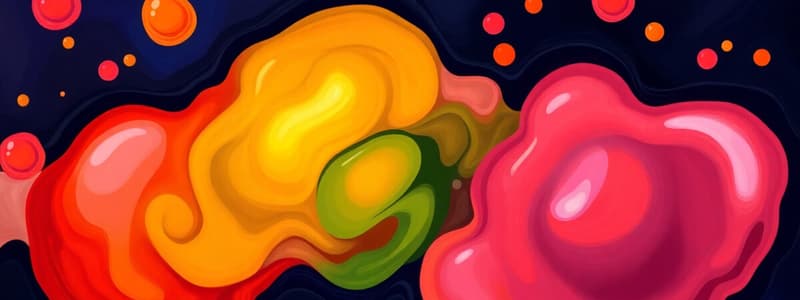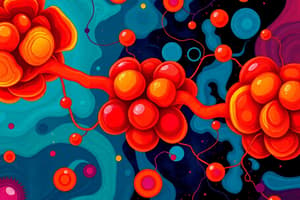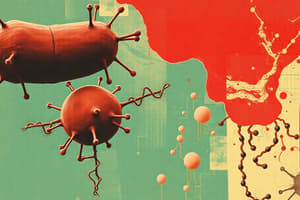Podcast
Questions and Answers
What is the main function of myoglobin?
What is the main function of myoglobin?
Myoglobin is responsible for storing oxygen in muscles.
What are the two main functions of hemoglobin?
What are the two main functions of hemoglobin?
Hemoglobin is responsible for transporting oxygen and carbon dioxide throughout the body. It also helps in blood buffering.
What type of protein are both myoglobin and hemoglobin?
What type of protein are both myoglobin and hemoglobin?
Both myoglobin and hemoglobin are hemoproteins.
What does the protein environment dictate?
What does the protein environment dictate?
What type of protein is myoglobin?
What type of protein is myoglobin?
Where is myoglobin mainly found?
Where is myoglobin mainly found?
What are the two forms in which myoglobin can exist?
What are the two forms in which myoglobin can exist?
Describe the tertiary structure of myoglobin.
Describe the tertiary structure of myoglobin.
Amino acid R-groups exposed on the surface of a globular protein are typically hydrophobic.
Amino acid R-groups exposed on the surface of a globular protein are typically hydrophobic.
Myoglobin contains two histidine residues in helices E and F.
Myoglobin contains two histidine residues in helices E and F.
What are the two histidine residues in helices E and F called?
What are the two histidine residues in helices E and F called?
What is F8 His designated as?
What is F8 His designated as?
What is a prosthetic group?
What is a prosthetic group?
Heme is a flat molecule.
Heme is a flat molecule.
What are the four cyclic groups in heme called?
What are the four cyclic groups in heme called?
Where does iron bind in the heme group?
Where does iron bind in the heme group?
Iron in the heme group is generally in the ferric state (Fe3+).
Iron in the heme group is generally in the ferric state (Fe3+).
How many bonds can iron form?
How many bonds can iron form?
What prevents oxidation of iron in myoglobin?
What prevents oxidation of iron in myoglobin?
Hemoglobin is a tetrameric protein.
Hemoglobin is a tetrameric protein.
The alpha chains of hemoglobin contain 8 alpha-helices.
The alpha chains of hemoglobin contain 8 alpha-helices.
How do the chains of hemoglobin interact with each other?
How do the chains of hemoglobin interact with each other?
Hemoglobin binds oxygen with a higher affinity than myoglobin.
Hemoglobin binds oxygen with a higher affinity than myoglobin.
What is the P50 value for myoglobin?
What is the P50 value for myoglobin?
What type of curve does the saturation curve of hemoglobin binding to oxygen have?
What type of curve does the saturation curve of hemoglobin binding to oxygen have?
What is the R-state of hemoglobin?
What is the R-state of hemoglobin?
How does the binding of oxygen cause a conformational change in hemoglobin?
How does the binding of oxygen cause a conformational change in hemoglobin?
Hemoglobin releases oxygen in tissues where the oxygen pressure is high.
Hemoglobin releases oxygen in tissues where the oxygen pressure is high.
What is the significance of the sigmoidal shape of the hemoglobin saturation curve?
What is the significance of the sigmoidal shape of the hemoglobin saturation curve?
A sudden drop in pulmonary capillary oxygen tension significantly affects hemoglobin saturation.
A sudden drop in pulmonary capillary oxygen tension significantly affects hemoglobin saturation.
Flashcards
Structure-function relationship
Structure-function relationship
The relationship between the structure of a molecule and its function. For example, how the shape of an enzyme allows it to bind to a specific substrate.
Globular proteins
Globular proteins
Proteins with a compact, spherical shape. They are usually soluble in water and have a diverse range of functions.
Myoglobin
Myoglobin
A protein found in muscle tissue that stores oxygen for use during periods of high energy demand.
Hemoglobin
Hemoglobin
Signup and view all the flashcards
Hemoproteins
Hemoproteins
Signup and view all the flashcards
Prosthetic group
Prosthetic group
Signup and view all the flashcards
Heme group
Heme group
Signup and view all the flashcards
Myoglobin as a monomer
Myoglobin as a monomer
Signup and view all the flashcards
Forms of myoglobin
Forms of myoglobin
Signup and view all the flashcards
Tertiary structure of myoglobin
Tertiary structure of myoglobin
Signup and view all the flashcards
Hydrophilic amino acids on surface
Hydrophilic amino acids on surface
Signup and view all the flashcards
Hydrophobic amino acids in interior
Hydrophobic amino acids in interior
Signup and view all the flashcards
Histidine residues in myoglobin
Histidine residues in myoglobin
Signup and view all the flashcards
Proximal histidine
Proximal histidine
Signup and view all the flashcards
Distal histidine
Distal histidine
Signup and view all the flashcards
Heme group structure
Heme group structure
Signup and view all the flashcards
Iron bonds in heme
Iron bonds in heme
Signup and view all the flashcards
Iron states and oxygen binding
Iron states and oxygen binding
Signup and view all the flashcards
Heme group interaction
Heme group interaction
Signup and view all the flashcards
Distal histidine as a gate
Distal histidine as a gate
Signup and view all the flashcards
Myoglobin's oxygen affinity
Myoglobin's oxygen affinity
Signup and view all the flashcards
P50 value
P50 value
Signup and view all the flashcards
Hemoglobin structure
Hemoglobin structure
Signup and view all the flashcards
Hemoglobin subunits
Hemoglobin subunits
Signup and view all the flashcards
Chain interaction in hemoglobin
Chain interaction in hemoglobin
Signup and view all the flashcards
Hemoglobin's oxygen binding function
Hemoglobin's oxygen binding function
Signup and view all the flashcards
Hemoglobin's saturation curve
Hemoglobin's saturation curve
Signup and view all the flashcards
Hemoglobin as an allosteric protein
Hemoglobin as an allosteric protein
Signup and view all the flashcards
T-state and R-state
T-state and R-state
Signup and view all the flashcards
Oxygen binding and conformational change
Oxygen binding and conformational change
Signup and view all the flashcards
Conformational change upon oxygen binding
Conformational change upon oxygen binding
Signup and view all the flashcards
Changes in hemoglobin structure
Changes in hemoglobin structure
Signup and view all the flashcards
Study Notes
Structure-Function Relationship: Globular Proteins (Myoglobin and Hemoglobin)
- Myoglobin stores oxygen in muscle tissue. Release occurs during oxygen deprivation.
- Hemoglobin transports oxygen and carbon dioxide, and buffers blood.
Hemoproteins
- Myoglobin and hemoglobin are hemoproteins.
- Hemoproteins contain heme as a prosthetic group (a non-protein group).
- The protein environment dictates the heme's function.
Structure of Myoglobin
- Myoglobin is a monomeric protein primarily found in muscle tissue.
- It contains a heme group, a prosthetic group.
- It exists in two forms: oxymyoglobin (oxygen-bound) and deoxymyoglobin (oxygen-free).
- The tertiary structure consists of eight alpha-helices connected by short non-helical regions.
Arrangement of Amino Acids in Myoglobin
- Amino acid R-groups exposed on the protein's surface are generally hydrophilic.
- Amino acid R-groups in the protein's interior are predominantly hydrophobic.
- Two histidine residues (E7 and F8) are exceptions: F8 is proximal His, and E7 is distal His.
Heme Group
- Both myoglobin and hemoglobin contain a heme group.
- The heme group is a prosthetic group covalently attached to the protein.
- The heme group is a flat molecule with four pyrrole rings.
- The structure contains iron (Fe) in its ferrous state (Fe2+).
Iron
- Iron binds in the center of the heme group's four rings.
- Iron is in the ferrous state (Fe2+) and forms 6 bonds.
- Four bonds are with ring nitrogens.
- One bond is with a histidine imidazole (proximal histidine).
- One bond is with oxygen (O2).
- Oxidation of iron (to Fe3+) prevents oxygen binding.
- Heme absorbs light and gives a deep red color.
Structure-Function Relationship (Myoglobin)
- The planar heme group fits into a hydrophobic pocket in the protein.
- The myoglobin-heme interaction is stabilized by hydrophobic attractions.
- The heme group stabilizes myoglobin's tertiary structure.
- The distal histidine acts as a gate. It opens and closes as oxygen enters and exits the hydrophobic pocket, binding to heme.
- The hydrophobic interior prevents iron oxidation, so the iron remains in the Fe2+ state and can bind another oxygen molecule.
Oxygen Binding to Myoglobin
- Myoglobin binds oxygen with a high affinity.
- The P50 (oxygen partial pressure required for 50% saturation) for myoglobin is approximately 2.8 torr or mm Hg.
- Myoglobin is almost fully saturated with oxygen at normal tissue conditions (around 20 mm Hg).
- The oxygen binding curve for myoglobin is hyperbolic.
Hemoglobin
- Hemoglobin is a tetrameric hemeprotein (four protein chains: two alpha and two beta).
- Each globin chain contains multiple alpha-helices.
Chain Interaction (Hemoglobin)
- The chains interact via hydrophobic interactions.
- Hydrophobic amino acids are present in both the interior and on the surface of protein chains.
Oxygen Binding to Hemoglobin
- Hemoglobin binds oxygen efficiently and becomes saturated in lungs (around 100 mm Hg).
- It releases oxygen in tissues where oxygen pressure is low (around 20 mm Hg).
Hemoglobin Saturation Curve
- The curve is sigmoidal (S-shaped)
- At 100 mm Hg, hemoglobin is 95-98% saturated with oxygen.
- Contrast to myoglobin, hemoglobin's P50 is ~26 mm Hg.
The Two Structures of Hemoglobin
- Hemoglobin exists in both low-affinity (T-state) and high-affinity (R-state) structures.
- The transition between these states is triggered by oxygen binding.
Hemoglobin is Allosteric
- Hemoglobin is allosteric: binding of a molecule at one site affects binding at a different site.
- Hemoglobin exists in two forms, T-state (taut/tense) and R-state (relaxed).
- The T-state has a low oxygen affinity. The R-state has a high oxygen affinity.
- Binding of oxygen causes conformational changes, shifting from the low-affinity T-state to the high-affinity R-state.
Oxygen Binding to Hemoglobin (2)
- Weak ionic and hydrogen bonds in deoxygenated hemoglobin.
- Strong hydrophobic interactions within oxyhemoglobin.
How Does the Structure Change?
- When heme is free of oxygen, it has a domed structure and the iron is outside the heme plane.
- When oxygen binds to iron, the heme adopts a planar structure, pulling the proximal histidine into the plane.
How Does the Structure Change? (2)
- Movement of iron and His triggers changes in the tertiary structure of individual hemoglobin subunits.
- Breakage of electrostatic bonds occurs in other oxygen-free hemoglobin chains.
- Myoglobin helix movement does not affect protein function.
The Saturation Curve is Sigmoidal (Cooperative)
- Conformational changes lead to cooperativity among binding sites.
- Binding of the first oxygen molecule breaks some salt bridges and increases the affinity.
- Binding further oxygen increases affinity even more.
- Binding is cooperative.
Protective Mechanism(High altitudes)
- A sudden drop in pulmonary capillary oxygen tension does not affect hemoglobin saturation.
Studying That Suits You
Use AI to generate personalized quizzes and flashcards to suit your learning preferences.



